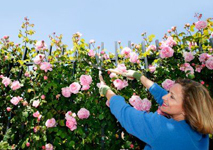Pruning and deadheading are essential to proper rose care. Alas, there are nearly as many opinions about how and when to prune as there are roses in need of pruning. While seasoned rosarians have their favourite tried-and-true methods, this article is geared toward new-comers who are unsure where to start. As time goes by, you may feel the urge to modify these techniques or even develop new ones of your own. Great! If it doesn't kill your roses, go right ahead.
Rose pruning isn't as complicated as some people make it out to be. In fact, there are only 7 basic rules. If you keep these in mind whenever you pick up your pruning shears, you'll be rewarded with beautiful bushes that reflect the care that you put into them.
Basic Pruning Rules
 1. Always remove any dead or decayed growth. This keeps your bushes looking good and denies disease and insects a place to call home.
1. Always remove any dead or decayed growth. This keeps your bushes looking good and denies disease and insects a place to call home.
2. Always keep the centre of the bush free of growth. This denies insects a place to live, and allows good air circulation to avoid fungus infection.
3. Remove crossing branches to promote stronger growth.
4. Shape your rose bushes as they grow. This will change them from wild and woolly to prim and proper, as all good roses should be.
5. Always using sharp pruning shears.
6. Clean the shears after each use to remove any disease or fungus spores.
7. Seal the cuts you've made on canes to keep out disease. Regular Elmer's glue works fine and it is cheap.
Pruning Terms And Techniques
 Hard (or "Low") Pruning
Hard (or "Low") Pruning
Cut canes back to 3 or 4 buds from the base or the bud unions. The end result will be strong canes about 4 to 5 inches in length. This pruning technique works best with new hybrid tea, grandiflora, and floribunda varieties. You should not do hard pruning with established bushes because they may not recycle. The only exception is as a last-ditch effort to revive sick or neglected bushes.
Moderate (or Medium) Pruning
Cut strong stems back to approximately half of their length. Weaker stems may be cut back even more, if needed. This technique works well with established gardens of floribundas, hybrid teas, grandifloras, and tree roses.
Light (High or Long) Pruning
Cut the canes back to around 2/3 of their length. After all the unwanted "wood" is removed, any remaining stems are "tipped". Light pruning is not usually recommended for most bushes, because it tends to produce early blooms and poorly developed flowers. Use this technique only if others are not working and the bush is an eyesore.
Proper pruning is easy, and it is the key to a happy, healthy rose garden.
By Ron King










Join the Discussion
Type out your comment here:
You must be logged in to post a comment.